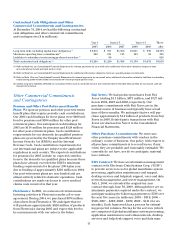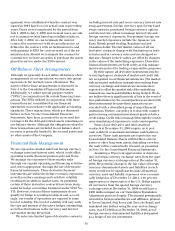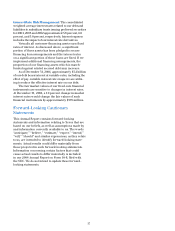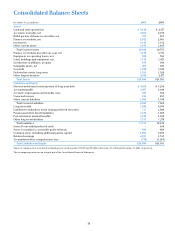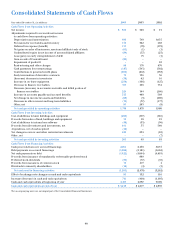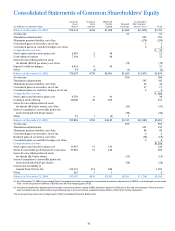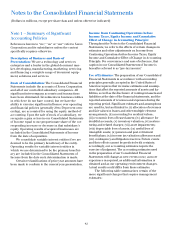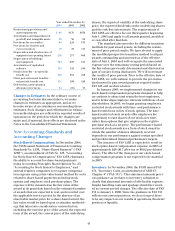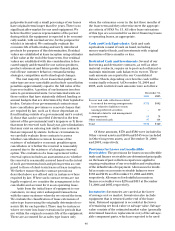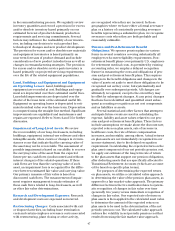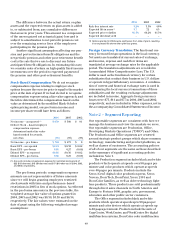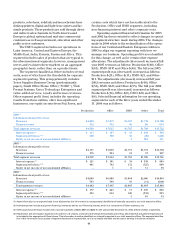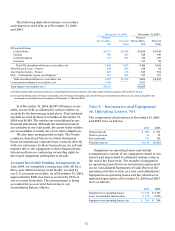Xerox 2004 Annual Report Download - page 46
Download and view the complete annual report
Please find page 46 of the 2004 Xerox annual report below. You can navigate through the pages in the report by either clicking on the pages listed below, or by using the keyword search tool below to find specific information within the annual report.
44
Goodwill and Other Intangible Assets: Effective
January 1, 2002, we adopted SFAS No. 142, “Goodwill
and Other Intangible Assets,” whereby goodwill was
no longer to be amortized, but instead is to be tested
for impairment annually or more frequently if an
event or circumstance indicates that an impairment
loss may have been incurred. We estimate fair value
by considering a number of factors including assess-
ing operating results, business plans, economic pro-
jections, anticipated future cash flows and market
data. In 2002, we recorded an impairment charge of
$63 as a cumulative effect of change in accounting
principle in the accompanying Consolidated
Statements of Income.
The following table presents the changes in the
carrying amount of goodwill, by operating segment,
for the three years ended December 31, 2004:
Production Office DMO Other Total
Balance at
January 1, 2002 $605 $710 $ 70 $121 $1,506
Foreign currency
translation
adjustment 82 55 (3) — 134
Impairment charge — — (63) — (63)
Divestitures
and other (4) (5) (4) — (13)
Balance at
December 31, 2002 683 760 — 121 1,564
Foreign currency
translation
adjustment 88 67 — 3 158
Balance at
December 31, 2003 771 827 — 124 1,722
Foreign currency
translation
adjustment 77 54 — 1 132
Other — — — (6) (6)
Balance at
December 31, 2004 $848 $881 $ — $119 $1,848
Intangible assets primarily relate to the Office
operating segment. Intangible assets were comprised
of the following as of December 31, 2004 and 2003:
As of December 31, 2004: As of December 31, 2003:
Weighted
Average Gross Gross
Amortization Carrying Accumulated Net Carrying Accumulated Net
Period Amount Amortization Amount Amount Amortization Amount
Installed customer base 17 years $218 $ 58 $160 $209 $ 45 $164
Distribution network 25 years 123 25 98 123 20 103
Existing technology 7years 105 74 31 103 56 47
Licensed technology (1) 7years 28 1 27 — — —
Trademarks 7 years 23 15 8 23 12 11
$497 $173 $324 $458 $133 $325
(1) Licensed technology is included in Other long-term assets in the Consolidated Balance Sheet at December 31, 2004.
Amortization expense related to intangible assets
was $38, $36, and $36 for the years ended December 31,
2004, 2003 and 2002, respectively, and is expected to
approximate $41annually through 2009. Amortization
expense is primarily recorded in Other expenses, net,
with the exception of amortization expense associated
with licensed technology, which is recorded in Cost
of sales and Cost of service, outsourcing and rentals,
as appropriate.
Revenue Recognition: In the normal course of
business, we generate revenue through the sale and
rental of equipment, service and supplies and income
associated with the financing of our equipment sales.
Revenue is recognized when earned. More specifically,
revenue related to sales of our products and services
is recognized as follows:
Equipment:Revenues from the sale of equipment,
including those from sales-type leases, are recognized
at the time of sale or at the inception of the lease, as
appropriate. For equipment sales that require us to
install the product at the customer location, revenue
is recognized when the equipment has been delivered
to and installed at the customer location. Sales of
customer installable products are recognized upon
shipment or receipt by the customer according to the
customer’sshipping terms. Revenues from equipment
under other leases and similar arrangements are
accounted for by the operating lease method and are
recognized as earned over the lease term, which is
generally on a straight-line basis.



